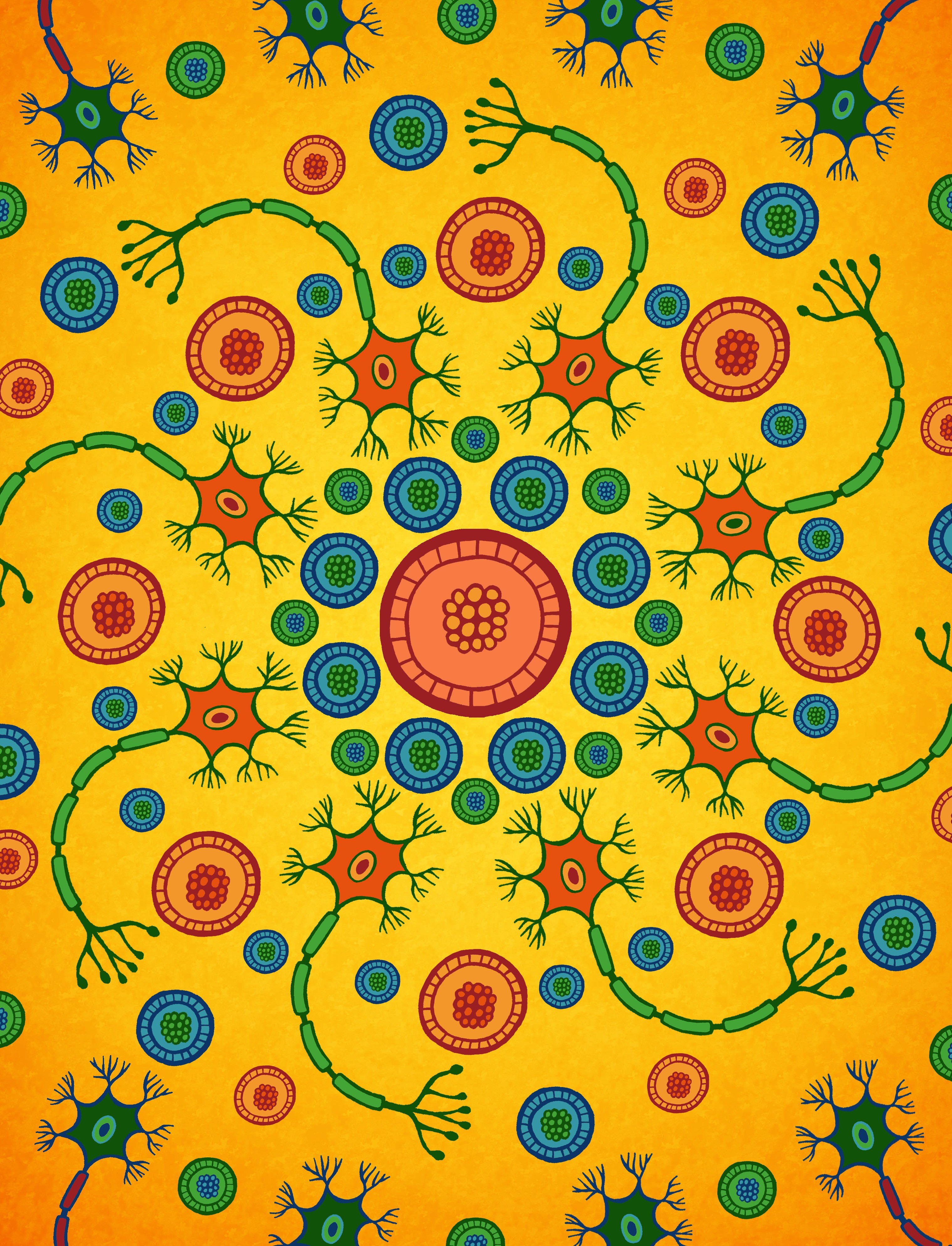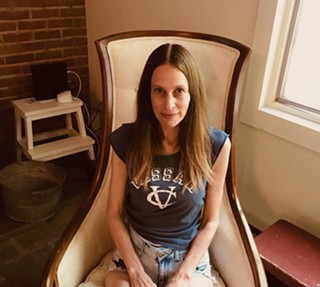Listen up, multiple sclerosis: You don't mess with Beth Broun. The fast-talking, black-clad native New Yorker, who was diagnosed with an aggressive form of multiple sclerosis in 2010, is determined to halt the progression of the autoimmune disease that is laying waste to her central nervous system. Broun, 50, walks with a cane and has to deal with daily ignominies such as weakness in her left leg and hand, severe drop foot, bladder problems, and faulty balance ("I look like I'm drunk when I walk without a cane," she says), but that doesn't stop her from waging all-out war against her disease. "MS is not for pussies—write that down," she says in an interview at her home in Woodstock. "I exercise like an animal at the gym every day and do tons of yoga and Pilates. I'm very conscious of food and eat no wheat or dairy. I practice Buddhism and chanting—that's another piece of the puzzle, you have to get spiritual. My mantra is 'Stop progression.' I'm a little over four years into this, and hey, I'm still walking."
Now Broun has another big gun on her side: her Manhattan-based neurologist, Saud Sadiq, MD, who is heading up a trailblazing FDA-approved stem cell trial for MS that's already showing promising results. It's important to note that these are not the controversial stem cells derived from human embryos—in this trial, the regenerative, powerhouse cells are harvested from the patient's own bone marrow. One year into the Stage I trial to determine the procedure's safety, preliminary results show early improvements in five out of nine patients, many of them badly affected by progressive MS. One patient, a mother of two, can now walk without a cane for the first time in six years and has regained sensation and function that she thought was lost forever. It's too soon to tell if the effects will last or if they'll transfer to a larger body of patients. But Broun and many others in the MS community are feeling something they hadn't dared to feel before: hope.
"One of the challenges in taking care of these patients is, can we repair neurological function? [In this trial] we're using the body's own stem cells to heal, because that would be a natural way of replacing lost cell structure," says Sadiq, who directs the Tisch MS Research Center of New York and runs his own state-of-the-art clinical facility next door, the International Multiple Sclerosis Management Practice (IMSMP). "So far, we haven't had any bad outcomes. It's early and we have to be cautious—there's a lot of work to be done. At least the trend we've seen in the first patients we've treated is that the procedure is safe and well tolerated." As for the unprecedented improvements in some patients, he adds, "We're very encouraged by these early results that we may actually be on to something."
Oh My, Oh Myelin
For Broun, meeting Sadiq was like finding a life raft in a sea of medical ineffectiveness. Her journey with MS started long before her diagnosis, when one spring day, walking along the Upper West Side with her husband, her left foot suddenly refused to budge. She went to a neurologist at Mt. Sinai Hospital who put her into physical therapy for six months and ordered an MRI of her lower back (not the place to find MS, which is in the brain and spinal cord). Broun had a high-powered, high-stress job selling ad space for Condé Nast—and very little time to seek the second opinion that she finally received two years later from a doctor at NYU. "He said, get your head into an MRI, and I did. In his office the next day, there was a picture of my brain on the wall and I said, wait a minute, do I have cancer? He said no. I said, do I have a brain tumor? And he said no, you have MS. I said, great, what's that?" Suffice it to say, Broun would soon learn everything about her disease—in which a misfiring immune system attacks the body's own healthy cells that produce myelin, the fatty substance that coats the nerves. With a loss of myelin, the nervous system literally short-circuits and cannot conduct electrical impulses across long distances—such as from the brain to the leg when walking.
Fast forward to more doctors and a slew of useless pharmaceuticals. "They put me on a medication that you inject every day, but it did nothing for me—it was a year of torture, sticking myself with needles," remembers Broun. Next came a pill, Gilenya, that wasted another two years with no results but carried a risk of serious side effects. One of Broun's doctors, who "had the bedside manner of my left toe," walked into the exam room one day when she was crying hysterically because her legs were burning in pain—and all he could say was "I hope you have a good psychotherapist."
After almost giving up on neurologists' ability to help her, Broun found Sadiq through Judy Bachrach, the Bearsville-based co-author of The MS Recovery Diet (Avery, 2007). At her initial consultation, Sadiq, who doesn't take insurance and doesn't come cheap, spent two-and-a-half hours with Broun. He took her off Gilenya and put her on Tysabri, a monthly chemotherapy infusion. For the first time, she got results: a return of some mobility in her left leg. Broun sees Sadiq as an out-of-the-box thinker who uses experimental therapies along with mainstream medicines—and who doesn't shy away from a special involvement and connection with each of his patients. At IMSMP, the clinic he built in 2006, the comprehensive team includes an MS-specializing naturopathic doctor and a physical therapist who works with neuroplasticity. Says Broun, "I've had appointments where Sadiq would lie down on the floor with me and show me how to talk to my muscles. He'd say, 'Leg, move. You need to do this.' I've never been more hopeful than with this doctor, with this place. It's unbelievable care."
Cells with Superpowers
Meanwhile, the MS stem cell research marches along, yet the FDA has limited the Stage I clinical trial to only 20 patients. Many others are hoping to be a part of the extended trial when that gets approved; Broun herself has started the process with a battery of tests, an MRI, venipuncture to remove 40 vials of blood, and the most harrowing procedure so far: a bone marrow aspiration, which she underwent on May 15 to harvest adult stem cells from her breastbone. To Broun's relief, the aspiration wasn't painful; the next step is to have her mesenchymal stem cells (or "msc's") separated out from the rest of her bone marrow, put into petri dishes, and fed nutrients that will make them divide and grow. "We might start with 1,000 cells and grow them to 100 million cells, a process that will take two to three months," says Violaine Harris, PhD, senior research scientist at the Tisch Center and a co-investigator with Sadiq on the clinical trial.
There's a helluva lot of potential in 100 million stem cells. These cells, which have not yet acquired a special function in the body, have the unique ability to renew themselves through cell division; this can allow them to replace or repair worn-out or damaged tissues in the body. "Stem cells can respond to signals to become specialized," says Harris, "so in that way they're very exciting for treating neurodegenerative disease, or any disease where you need to generate new cells. Thinking about MS, the goal is to give the stem cells signals to specialize into cells that will make new myelin for regenerating nerve tissue." Once Harris and her team have about 100 million stem cells, they introduce specific growth factors. This signals the cells to become neural progenitors—special cells that may help to rebuild the nervous system.
As neural progenitors, the cells are ready to be re-introduced back into the patient. Sadiq's method is to inject them into the spinal fluid in three doses, spaced three months apart over a total of six months. In animal models, researchers found that the cells respond to the stimuli of injured areas, going right to the root of the problem. "Probably the most important thing they do is turn on your own resident brain stem cells that have been lying dormant for some reason," he says. "We think that's what actually does the repair, if there is any repair." One risk in stem cell therapy is that the cells will keep multiplying and become cancer cells. "Luckily, we haven't seen any of that in animal studies," says Sadiq. Other dangers include infections and seizures, but so far, no instances of either have come up. If the trial continues to show efficacy, the treatment could also help patients with Lou Gehrig's disease (ALS), spinal cord injury, cerebral palsy, Parkinson's disease—all considered incurable right now. Some overseas clinics already offer stem cell treatments, but their methods have not been tested. "They're taking advantage of people's desperation," warns Harris, who advises waiting for the science. "If no one has done the studies, you really don't know what you're getting."
A Need for Brain Power—and Bucks
The only thing threatening to hold back the Tisch trial right now is money: Surprisingly, the major MS nonprofit organizations have not yet stepped up to the plate to fund this particular stem cell research. Up to now, Tisch has relied on private, grassroots fundraising—much of it spearheaded by dedicated Sadiq patients such as Liz Maslow Montesano, a Rhinebeck resident who was diagnosed with MS 13 years ago and who will have her own stem cells harvested on July 24. The former co-owner of a wedding photography business with her husband, Montesano (who, like many MS patients, has had to stop working) has struggled with considerable disability in her left leg; daily challenges have ranged from walking and putting on her clothes to symptoms such as pins-and-needles pain, numbness, and a crushing fatigue that comes and goes. Cognitively, she's clear, "and that's a gift to me," she says. In addition to fundraising for Tisch, she also mentors newly diagnosed MS patients: "I walk them through the first part of the journey and maybe alleviate some of their fears. I let them take a look at me and see that even though there's a disability, I'm still here. I have the greatest doctor in the world and the greatest support team."
Every case of MS is different—many people get around in wheelchairs and some lose their eyesight and other vital functions, while an increasing number of relapse-remit patients do extremely well with today's available medicines and may never become diasbled. As for the stem cell developments that are brewing right here in New York, Montesano views them with what she calls "guarded optimism." Broun, her friend, permits herself to dream big. "If I keep walking, I promise I'll tap dance naked down Tinker Street," she says. "With Sadiq, with yoga, with stem cells—I'm totally going to win."
To donate, visit Tischms.org.
RESOURCES
International Multiple Sclerosis Management Practice Imsmp.org
Tisch MS Research Center of New York Tischms.org













